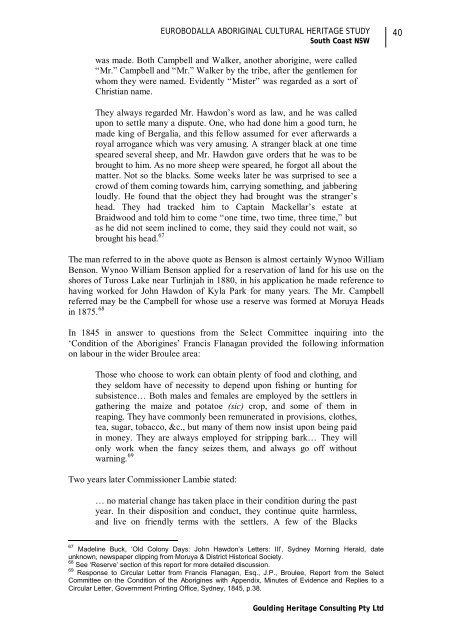Pages 9 - 77 (1600kb) - Eurobodalla Shire Council
Pages 9 - 77 (1600kb) - Eurobodalla Shire Council
Pages 9 - 77 (1600kb) - Eurobodalla Shire Council
Create successful ePaper yourself
Turn your PDF publications into a flip-book with our unique Google optimized e-Paper software.
EUROBODALLA ABORIGINAL CULTURAL HERITAGE STUDY<br />
South Coast NSW<br />
was made. Both Campbell and Walker, another aborigine, were called<br />
“Mr.” Campbell and “Mr.” Walker by the tribe, after the gentlemen for<br />
whom they were named. Evidently “Mister” was regarded as a sort of<br />
Christian name.<br />
They always regarded Mr. Hawdon’s word as law, and he was called<br />
upon to settle many a dispute. One, who had done him a good turn, he<br />
made king of Bergalia, and this fellow assumed for ever afterwards a<br />
royal arrogance which was very amusing. A stranger black at one time<br />
speared several sheep, and Mr. Hawdon gave orders that he was to be<br />
brought to him. As no more sheep were speared, he forgot all about the<br />
matter. Not so the blacks. Some weeks later he was surprised to see a<br />
crowd of them coming towards him, carrying something, and jabbering<br />
loudly. He found that the object they had brought was the stranger’s<br />
head. They had tracked him to Captain Mackellar’s estate at<br />
Braidwood and told him to come “one time, two time, three time,” but<br />
as he did not seem inclined to come, they said they could not wait, so<br />
brought his head. 67<br />
The man referred to in the above quote as Benson is almost certainly Wynoo William<br />
Benson. Wynoo William Benson applied for a reservation of land for his use on the<br />
shores of Tuross Lake near Turlinjah in 1880, in his application he made reference to<br />
having worked for John Hawdon of Kyla Park for many years. The Mr. Campbell<br />
referred may be the Campbell for whose use a reserve was formed at Moruya Heads<br />
in 1875. 68<br />
In 1845 in answer to questions from the Select Committee inquiring into the<br />
‘Condition of the Aborigines’ Francis Flanagan provided the following information<br />
on labour in the wider Broulee area:<br />
Those who choose to work can obtain plenty of food and clothing, and<br />
they seldom have of necessity to depend upon fishing or hunting for<br />
subsistence… Both males and females are employed by the settlers in<br />
gathering the maize and potatoe (sic) crop, and some of them in<br />
reaping. They have commonly been remunerated in provisions, clothes,<br />
tea, sugar, tobacco, &c., but many of them now insist upon being paid<br />
in money. They are always employed for stripping bark… They will<br />
only work when the fancy seizes them, and always go off without<br />
warning. 69<br />
Two years later Commissioner Lambie stated:<br />
… no material change has taken place in their condition during the past<br />
year. In their disposition and conduct, they continue quite harmless,<br />
and live on friendly terms with the settlers. A few of the Blacks<br />
67 Madeline Buck, ‘Old Colony Days: John Hawdon’s Letters: III’, Sydney Morning Herald, date<br />
unknown, newspaper clipping from Moruya & District Historical Society.<br />
68 See ‘Reserve’ section of this report for more detailed discussion.<br />
69 Response to Circular Letter from Francis Flanagan, Esq., J.P., Broulee, Report from the Select<br />
Committee on the Condition of the Aborigines with Appendix, Minutes of Evidence and Replies to a<br />
Circular Letter, Government Printing Office, Sydney, 1845, p.38.<br />
Goulding Heritage Consulting Pty Ltd<br />
40
















